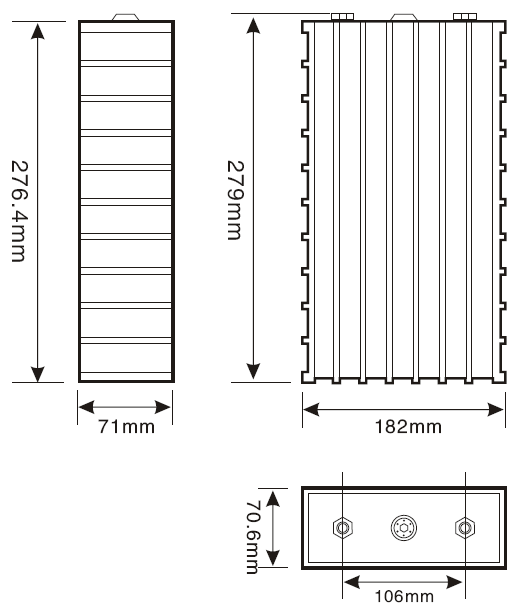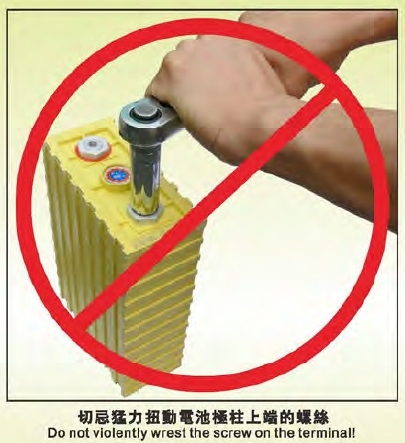Table of Contents
Battery
The battery on the Armadillo Scout is a 48 VDC (52.2 VDC) 160 Ah Lithium Yttrium batterypack consisting of 16 3.2 VDC batterycells.
Supplyer: GWL/Power
Overview
Cells mounted on the robot
<columns 100% first column attributes 50% second column attributes → Front of robot <graphviz dot center> digraph Overview {
rankdir=TB
node [shape=record];
battery1[label="<a1> A1|<a2> A2|<a3> A3|<a4> A4"];
} </graphviz> <graphviz dot center> digraph Overview {
rankdir=TB
node [shape=record];
battery2[label="<b1> B1|<b2> B2|<a3> B3|<B4> B4"];
} </graphviz> <graphviz dot center> digraph Overview {
rankdir=TB
node [shape=record];
battery3[label="<c1> C1|<c2> C2|<c3> C3|<c4> C4"];
} </graphviz> <graphviz dot center> digraph Overview {
rankdir=TB
node [shape=record];
battery4[label="<d1> D1|<D2> D2|<D3> D3|<D4> D4"];
} </graphviz>
<newcolumn> Voltage measured after accident <graphviz dot center> digraph Overview {
rankdir=TB
node [shape=record];
battery1[label="<a1> A1\n 3.3 VDC|<a2> A2\n Dead|<a3> A3\n 3.4 VDC|<a4> A4\n 3.3 VDC"];
} </graphviz> <graphviz dot center> digraph Overview {
rankdir=TB
node [shape=record];
battery2[label="<b1> B1\n 3.34 VDC|<b2> B2\n 3.33 VDC|<a3> B3\n 3.33 VDC|<B4> B4\n 3.33 VDC"];
} </graphviz> <graphviz dot center> digraph Overview {
rankdir=TB
node [shape=record];
battery3[label="<c1> C1\n 3.34 VDC|<c2> C2\n 3.34 VDC|<c3> C3\n 3.34 VDC|<c4> C4\n 3.33 VDC"];
} </graphviz> <graphviz dot center> digraph Overview {
rankdir=TB
node [shape=record];
battery4[label="<d1> D1\n 3.34 VDC|<D2> D2\n 3.33 VDC|<D3> D3\n 3.34 VDC|<D4> D4\n 3.34 VDC"];
} </graphviz> </columns>
Bettarycell
LFP160AHA - WB-LYP160AHA (3.2V/160Ah) - LiFeYPO4
Specifications
| Model name | LFP160AHA | Older product marking TS-LFP160AHA, TS-LYP160AHA |
| Nominal voltage | 3.2 V | Operating voltage under load is 3.0 V |
| Capacity | 160 AH | +/- 5% |
| Operating voltage | max 4.0V - min 2.8V | At 80% DOD |
| Deep discharge voltage | 2.5 V | The cells is damaged if voltage drops bellow this level |
| Maximal charge voltage | 4.0 V | The cells is damaged if voltage exceeds this level |
| Optimal discharge current | < 80 A | 0.5 C |
| Maximal discharge current | < 480 A | 3 C, continuous for max 15 minutes from full charge |
| Max peak discharge current | < 3200 A | 20 C, maximal 5 seconds in 1 minute |
| Optimal charge current | < 80 A | |
| Maximal charge current | < 480 A | |
| Maximal continuous operating temperature | 80 °C | The battery temperature should not increase this level during charge and discharge |
| Dimensions | 182x71x277 mm | Millimeters (tolerance +/- 2 mm) |
| Weight | 5.8 kg | Kilograms (tolerance +/- 150g) |
Dimensions

Initial Charge

The above is the offical TS instruction for the first charge of the LFP batteries. Please see more details here.
Question: Is there a difference between charging to 4.0V and 4.2V?1)
Generally there is no signicicant difference. The voltage increase from 4.0V to 4.2V is very fast. If you charge to 4.2V it is 100% DOD cycle. If you charge to 4.0 it is 97% and more of the DOD cycle.
Question: How should new cells 3.2V 40AH, 60AH, 90AH, 100 AH, etc. be formed before first usage?2)
The new 3.2V LFP cells delivered from the warehouse are partially charged. However before the first use, it is essential to charge each cell to full capacity. The initial charging should be done with the charging current set to less than 1C (typically 0.5C), till the voltage level of 4.0 V is reached.
There is no other need for LFP 3.2V cells to be formatted or otherwise specially prepared for the use. After the first charge to full, the cell is ready to be used for use.
The above charging rule is also applied to the initial charge after the cell has been unused or stored for a long time. If not used more than 1 month, it is recommended to make again an initial charge to full.
Important: if you plan not to use the cells for a long time, before storing you must charge cells to full. In the case of storage longer than 1 year, it is required to recharge each cell after 12 months to full.
Battery Terminals

Never apply excessive force to the terminal connectors!
Applying excessive force to tighten or release the bolts of the terminal connectors can cause whole terminal to move (rotate). The result is a damage of the internal structure of the cell that cannot be repaired. No warranty can be applied for such kind of the cell abuse.
